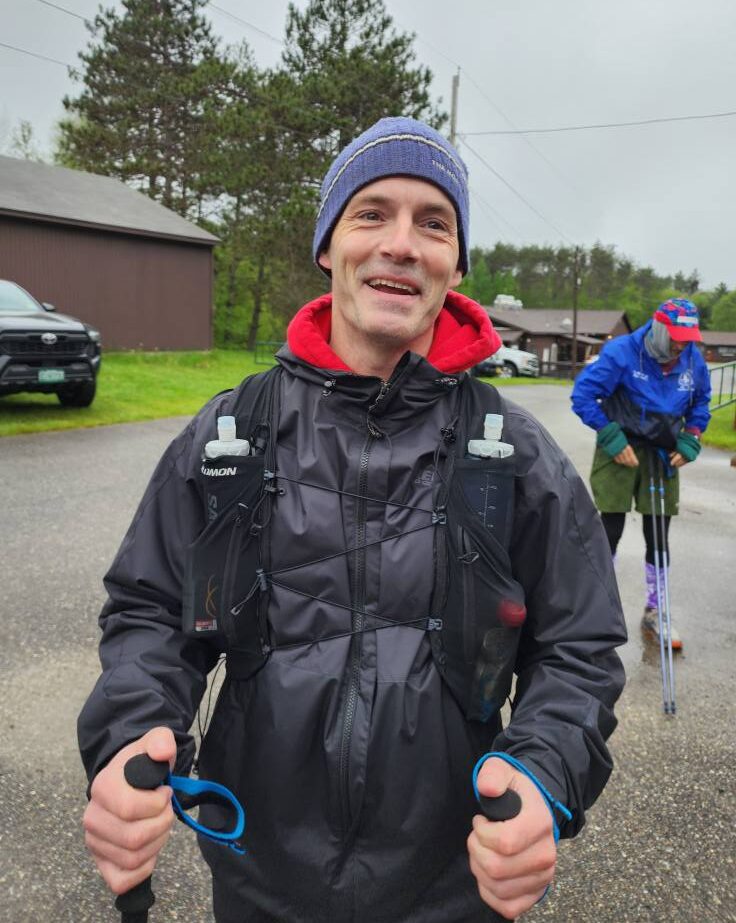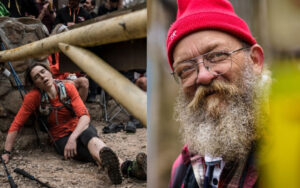
About that race…
When I got to Infinitus, people were in winter hats and jackets. Vermont is experiencing its coldest May on record. As for running, that means good temperatures and no bugs. But they also said leading up to the race they’d had rain like they’ve never had and the course was muddier than it had ever been.
That was not a lie.
There’s not much point in talking about how muddy it was. Any adequate description I can give is just going to sound like a wild exaggeration. But everyone who was on that course knows, because they all had the same look of shock and disbelief by the end of Day 1.
I’ve done a lot of muddy courses, wet courses, sloppy courses. Nothing holds a candle to this. The topography of the area meant the trails seemed to cradle every drop of water. You’d think over 27 miles, there’d be a few sections that were mud free. But it was always present. And it wasn’t just messy mud. It was deep, thick, wet mud that enveloped and gripped your feet and trekking poles. It was like trying to run a course through thick, wet peanut butter.
Instead of running, I was fighting the mud. Slipping, falling, stabilizing, constantly catching, pulling. I’m slow, especially on the uphills and straightaways, but make up time by bombing my downhills. To complete the 250, I didn’t have much margin for error to begin with. Now those treacherous, slippery downhills meant I had to go slow. After two full circuits (54 miles), I was three hours off my pace from the 100 the previous year, an unsustainable pace if I hoped to get any sleep over the five days.
Additionally, I was getting the crap beat out of me. I expected to get beat up during the race and have to push through some stuff, but all that physical battling with the mud meant I was having what I expected to be Day 3 problems on Day 1. My third short loop was a painful, agonizing shuffle that took nearly five hours when it should have taken no more than three-and-a-half. It was clear my 250 was over, so I called it after 64 miles.
I know I could have made other choices and chased a moral victory. I could have stayed up there the rest of the time and chased some more miles just to see what I could get. But the 250 was a loss, it was a failure, and I could accept that, lick my wounds, recover, and move on. Failure is part of the gig. The possibility of failure — and, with something of this magnitude, the PROBABILITY of failure — is exactly the thing that gives it value and makes it appealing. A lot of folks are afraid of failure because they take it personally and only view it with self-judgement. But do enough of these things and you get comfortable coexisting with failure. There is no really great accomplishment unless there is also the very real possibility of failure. In that way, failure is kind of a mentor, a copilot on this journey. And if you let it, it can help guide you to bigger, better things, and even help you grow as a person. So, I tried and failed. This year.
Still, it stung. Immediately after, I was feeling pretty down. But three conversations I had with other people really helped put things in perspective. One was with the race director, when I was questioning my prep, he basically said nobody there really got to test their prep as the course was such a different animal this year it dictated things. “You just don’t know.”
A conversation with another racer was reassuring because his experiences and take mirrored my own: the brutal course, the feeling it was getting worse, the Day 3 problems on Day 1. It helped to know everyone else was being hit with the same stuff. (Lots of DNFs this year. At last check, all of the 888Ks had DNFed, the DECA — a marathon a day for 10 days — was down from 12 participants to four, and four off the five 250 runners had DNFed, with the lone remaining guy — a world-record holder in some endurance event — still having an outside shot, but it’s going to be a hell of an effort to pull off. All of these folks were complete studs, and I have zero doubt each would have finished this thing in a normal year. I felt very insecure about showing up alongside them. 😄)
A conversation with a volunteer summed things up when he basically said you can question yourself all you want, but look at some of these other folks. The elites of the elite. Some are as close to actual superheroes that you’ll ever find, and they are hitting the same thing. It shows you can do everything right — get your physical prep dialed in, nutrition, gear, strategy, everything — and you show up and get wildcard conditions like this. No matter how much prep you do, there are still a lot of factors that are going to be outside of your control.
A lot like life.


